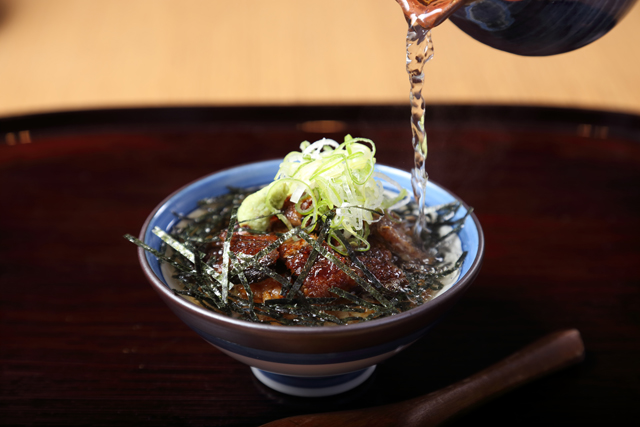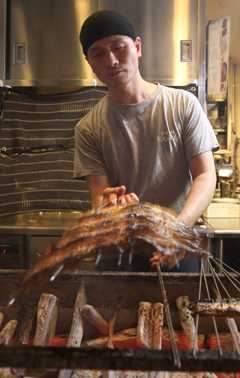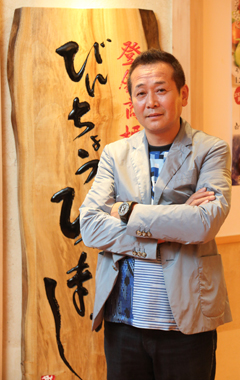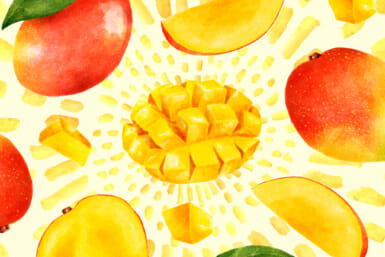The philosophy and flavor that has made this grilled eel restaurant a hit around Japan could eventually send it overseas.
By Alec Jordan
One of the things that Nagoya is best known for is great food: some of its famous dishes include tebasaki (fried chicken wings), miso-katsu (pork cutlet covered with a thick miso sauce), and tenmusu (shrimp tempura riceballs). Another favorite dish in this central Japanese city is unagi, or eel, and the local style of preparation is distinctive for two reasons: it is grilled, not steamed, and it is traditionally served as hitsumabushi, which is eaten in three different stages, each one highlighting a different aspect of the flavors and textures of the charcoal-roasted unagi.
Hitsumabushi Bincho is the first franchise to take this cuisine outside of Nagoya, and president Hiroshi Suzuki explained to us that he isn’t satisfied with just spreading this style of cuisine—and the dedication and attention to detail that goes into it—around Japan. His aim is to share this dish with the world.
Digging in
And it is definitely a cuisine worth sharing. The eel is grilled over high-quality charcoal that is made from oak wood (bincho), and grilling, rather than steaming—the way unagi is often prepared, especially around Tokyo—is part of Hitsumabushi Bincho’s secret. Of course, this gives the unagi a smoky flavor that perfectly complements the complex sweetness of the kabayaki sauce it’s glazed in, but it also makes the meat slightly crunchy on the outside, and soft yet solid on the inside.
The other thing that makes hitsumabushi unique is the way you eat it. At Hitsumabushi Bincho, you can order unadon and unajū (a bowl or a flat box filled with rice and topped with eel, respectively), but our recommendation is to eat the dish that gives the franchise its name: the eel cut into small pieces, and served over rice in a large round bowl. You eat it in three steps: First, you scoop about a third of your portion into a smaller bowl and mix the rice and eel together. Next, you then take another third, this time topping it with wasabi and green onions. Finally, you serve yourself the last helping, add seaweed, wasabi, and green onions, and finally pour dashi (broth) on top of all of it. Each stage lets you savor different qualities of these seemingly simple ingredients.
Ingredients and Skill Make the Meal
As Suzuki explains, there is a tremendous amount of depth that goes into cooking something as seemingly simple as an eel, and one of the things that makes a good unagi cook is knowing how to prepare different varieties. This is one of the reasons that Suzuki is so particular about the eel that he uses in his shops. Even within the same species (in Japan, it’s mostly Anguilla japonica), there are many varieties of eel and each one, depending on how much fat it might have in its
body, requires a different amount of heat to cook properly. And each eel needs to be turned at precisely the right time on the grill.
Steaming eel is a different process. “Part of what makes the tradition of steaming eel is that it can be simpler: you can usually be sure of how the eel will turn out,” Suzuki explains. “But grilling requires more precision, and therefore more training. Many places that prepare eel around Tokyo have hitsumabushi on their menus, but this eel is steamed, not grilled. If it’s steamed, it’s so soft that you can cut it with your chopstick. When it comes to the third step of hitsumabushi (adding the dashi), the eel will just fall apart.”
Suzuki explained the importance of timing by comparing it to something that might be more familiar to the western palate: “Just like if you are cooking a steak, depending on the amount of fat, you have to know how high of a temperature you should use, and you have to know just when to turn it. That’s part of what it means to be an artisan. It’s the same with eel. You have to be able to look at it and recognize how quickly it needs to be turned over.”
He explains that quickly perceiving these different elements isn’t something that you can really teach: “it’s something that you come to understand by yourself with experience. That’s the technique of any craftsperson.” He adds that many elements of his ten years of training were trying, “but that was to be expected: if you’re truly putting your all into it, there will always be difficult elements, whether it’s managing people, or cooking, or doing anything else.”
Expanding the Hitsumabushi Bincho Brand
After ten years of working under master cooks, Suzuki opened his first shop in Nagoya in 1992. He launched a second location 13 years later and took a major step in spreading the Hitsumabushi Bincho brand when he opened his Ginza shop in 2007. Last year brought a location at Sky Tree Solamachi, and this year was the franchise’s first step into Osaka.
The franchise now has eight locations, from Fukuoka to Ikebukuro, and Suzuki shows no signs of slowing down. Being able to share this Nagoya cuisine with greater Japan was his original idea, but he also wants to share hitsumabushi with a global audience. Suzuki explains that reaching international customers is the next step to opening shops outside of Japan.
New York is first on his mind, but he is also considering Singapore, Jakarta and Taiwan. Eel is getting to be more well-known at Japanese restaurants worldwide, but Suzuki is looking forward to seeing foodies recognize the subtle differences that go into making hitsumabushi stand out the way it does: “If this food culture can be passed around Japan and to other countries, I would be happy; it would be my dream. I would love to hear people in New York say, ‘I know hitsumabushi’.”
Finally, he explains, being able to take the time to enjoy food that has been prepared with skill and consideration isn’t just a luxury, it’s a need from time to time. And it certainly tastes better: “If you just pop something in the microwave and punch a few buttons, you’re not going to get something real, something delicious.” After being able to enjoy the flavors of Hitsumabushi Bincho’s signature dish, we agree wholeheartedly, and hope that Suzuki’s dream of sharing flame-grilled unagi with the world comes true.
Hitsumabushi Locations in Tokyo:
Tokyo Skytree Town, Solamachi 6F, 1-1-2 Oshiage, Sumida-ku, Tokyo
Tel: 03-5619-5757 | Web: www.hitsumabushi.co.jp
Open: Daily, 11:00–22:00
Ginza | Tel: 03-5159-0231
Ikebukuro PARCO | Tel: 03-5956-5756
Outside of Tokyo
Nagoya:
Head Store | Tel: 0587-96-0141
LACHIC | Tel: 052-259-6703
Esca | Tel: 052-451-5557
Osaka:
Grand Front | Tel: 06-6371-5759
Fukuoka:
Nakasu Kawabata | Tel: 092-409-6522











